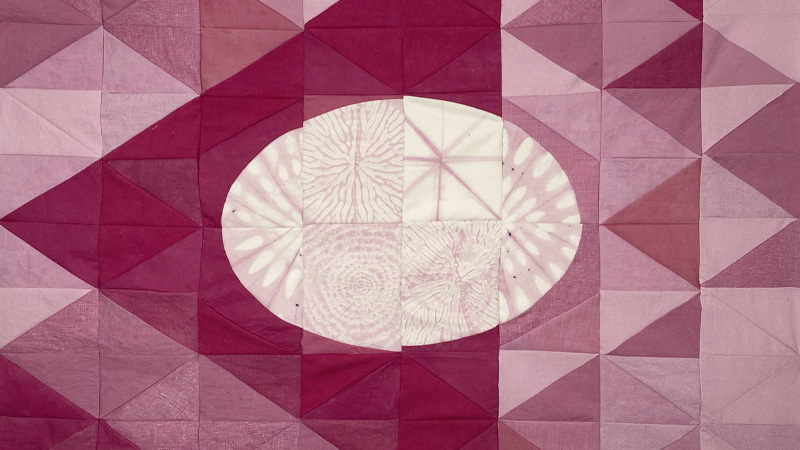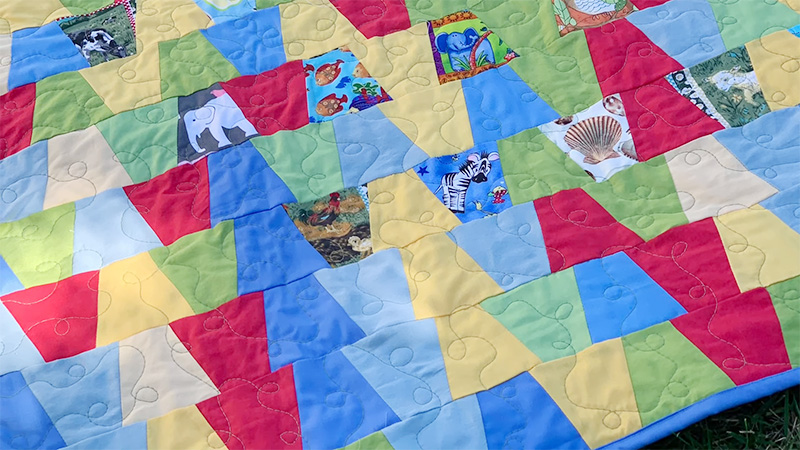Quilting is an art that weaves together creativity and craftsmanship, resulting in beautiful, cozy creations. While the quilt top steals the spotlight, the often-overlooked quilt backing plays a crucial role in the overall aesthetic and functionality of your quilt.
It’s the canvas that completes your masterpiece. In this guide, we’ll explore a world of possibilities for quilt-backing ideas that go beyond the ordinary. Whether you’re a seasoned quilter looking to experiment or a beginner seeking inspiration, we’ve got you covered.
From classic choices like solid colors and traditional prints to unconventional selections like upcycled fabrics and personalized designs, we’ll delve into a range of quilt backing ideas to spark your imagination.
Discover how the right backing can enhance the visual appeal, durability, and comfort of your quilt. Let’s embark on a journey through these inventive quilt-backing ideas, helping you transform your quilts into cherished works of art.

Quilt Backing Ideas
The quilt backing not only provides structural support but also contributes to the overall aesthetic and comfort of the quilt. In this comprehensive guide, we’ll explore a world of creative quilt-backing ideas that will help you take your quilting projects to the next level.
Classic Solids
One timeless choice for quilt backing is solid-colored fabric. Solid colors, whether bold or muted, provide a clean and elegant backdrop for your quilt. They complement any quilt top design and are versatile enough to suit various quilt themes and styles.
Consider using a solid color that complements or contrasts with the colors in your quilt top. For a contemporary look, opt for vibrant, jewel-toned solids, or go for a softer touch with pastel shades. Solid-colored backings also provide an excellent opportunity to showcase intricate quilting stitches.
Traditional Prints
Traditional prints never go out of style. Floral, paisley, and geometric prints in classic color palettes can lend a vintage charm to your quilt. These prints can evoke a sense of nostalgia and make your quilt feel like a cherished heirloom.
When selecting traditional print backing fabric, pay attention to scale and color coordination. Ensure that the print complements the theme and colors of your quilt top while creating a harmonious overall look.
Modern Geometrics
For a contemporary twist, consider geometric prints for your quilt backing. Bold, graphic designs can add a touch of modernity to your quilts. Geometric patterns with clean lines and vibrant colors can create a striking contrast with the traditional look of patchwork quilt tops.
Experiment with patterns like chevrons, stripes, or abstract geometrics to infuse a sense of dynamism into your quilting projects. Geometric backings work particularly well for quilts with a modern or minimalist aesthetic.
Batik Brilliance
Batik fabrics are known for their stunning patterns and vibrant colors. These hand-dyed fabrics, often with intricate motifs, can be an excellent choice for quilt backings. Batiks offer a touch of exoticism and a burst of color, making them perfect for quilts with a global or bohemian flair.
The unique dyeing process of batiks results in variations in color intensity, creating a visually rich and textured quilt backing. The irregularities add character and depth to your quilt.
Flannel for Warmth
If you’re looking to create a cozy, snuggle-worthy quilt, consider using flannel as your backing fabric. Flannel is exceptionally soft and warm, making it ideal for quilts intended for cold winter nights or cuddling on the couch.
Choose solid-colored flannel for a classic look or select flannel with fun prints like plaid or animals for a whimsical touch. Flannel-backed quilts are not only comfortable but also perfect for gifting.
Double-Sided Quilts
Why settle for one quilt backing when you can have two? Double-sided quilts offer versatility and a reversible design. Use contrasting fabrics or complementary color schemes on each side of the quilt to create a unique piece that can be flipped to suit your mood or decor.
Double-sided quilts are a bit more challenging to make, but the effort pays off with a quilt that’s twice as stylish and functional.
Upcycled Treasures
Embrace sustainability by using upcycled materials as quilt backing. Old bedsheets, vintage fabric finds, or even worn denim jeans can be repurposed as backing fabric. Upcycling not only reduces waste but also adds character and history to your quilt.
When using upcycled materials, ensure they are clean and in good condition. You can even incorporate pockets or buttons from old clothing into the backing for a quirky and personalized touch.
Personalized Backings
Take your quilt to the next level of customization by designing your own backing fabric. Create a unique fabric print using services that allow you to upload your artwork or photos.
This option is perfect for commemorating special occasions or turning cherished memories into quilts. Consider printing family photos, children’s artwork, or meaningful quotes on the backing to add a deeply personal touch to your quilting projects.
Minky Magic
Minky fabric is exceptionally soft and plush, making it an excellent choice for quilt backings, especially for baby quilts. Its luxurious texture adds a layer of comfort, making the quilt perfect for cuddling.
Minky comes in various colors and textures, including dimpled, embossed, or printed varieties. You can match the minky backing to the theme or color scheme of your quilt top for a cohesive look.
Quilt-as-You-Go Backing
Quilt-as-you-go (QAYG) is a technique where you quilt each block individually before assembling them into a quilt. With this method, you can use different fabrics for each block’s backing, creating a visually dynamic quilt.
This technique allows you to experiment with a variety of backing fabrics and styles within a single quilt. QAYG backings can be a great opportunity to showcase your creativity and quilting skills. You can mix and match fabrics, patterns, and even quilting motifs for each block.
Why the Quilt Backing Matters?

The backing fabric may seem like a mere supporting actor, but it plays a pivotal role in the overall success of your quilt. Let’s delve into why the quilt backing matters and explore its multifaceted importance.
Structural Integrity
First and foremost, the quilt backing provides structural support to the quilt. It acts as the foundation that holds the entire quilt together. Without a sturdy backing, the quilt layers, including the top and batting, would lack cohesion, resulting in a fragile and unreliable final product.
Durability
A well-chosen backing fabric can significantly impact the longevity of your quilt. It acts as a protective barrier, shielding the batting and quilt top from wear, tear, and potential damage.
Durability is particularly important if your quilt will be subjected to frequent use, washing, or even passing down through generations.
Visual Appeal
While the quilt backing isn’t typically the star of the show, it should harmonize with the quilt top’s design and color scheme. When the quilt is folded or draped, the backing becomes visible, providing an opportunity to enhance the overall visual appeal.
A carefully selected backing can complement or contrast with the quilt top, adding depth and interest to the finished piece.
Comfort and Warmth
The choice of backing fabric also influences the comfort and warmth of your quilt. Fabrics like flannel, minky, or other plush materials can enhance the cozy factor, making the quilt perfect for snuggling on chilly nights. Conversely, lighter, breathable fabrics may be more suitable for warm weather.
Quilting Design Showcase
The backing fabric sets the stage for quilting designs. Whether you’re opting for intricate free-motion quilting, straight-line quilting, or any other quilting style, the backing’s color and texture can accentuate the beauty of your stitches. It’s like choosing the perfect frame for a piece of artwork.
Personal Expression
Quilts are often created with love and care, making them not just functional but deeply personal. The choice of quilt backing provides an additional opportunity for personal expression.
It allows you to infuse your personality, preferences, and memories into your quilts. Whether you opt for a simple solid or a custom-printed backing, your choice tells a story.
Theme Reinforcement
For themed or special occasion quilts, the backing can reinforce the chosen theme. If you’re creating a quilt for a baby shower, for example, a backing featuring baby animals or soft pastels can enhance the theme and make the quilt more memorable.
Practical Considerations
Beyond aesthetics, the backing fabric may also serve practical purposes. For instance, if you’re crafting a picnic quilt, a waterproof or stain-resistant backing can help protect against spills and damp ground. Understanding the intended use of your quilt can guide your choice of backing material.
FAQs
What is the difference between quilt top and batting in quilting?
The quilt top is the decorative layer of the quilt, often made up of patchwork blocks or other fabric designs. Batting, also known as wadding, is the insulating layer between the quilt top and backing, providing warmth and thickness.
How do I choose the right batting for my quilt?
Select batting based on your preferences for warmth, loft, and drape. Common types include cotton, polyester, wool, and blends. Consider the quilt’s use; cotton is breathable and suitable for most quilts, while wool offers excellent warmth.
What’s the best way to secure quilt layers together during the quilting process?
Quilters commonly secure the layers using a technique called basting, using pins, spray adhesive, or basting stitches. Quilting can be done by hand with needle and thread or by machine using various quilting patterns.
How can I properly care for and clean my quilt?
Always check the care instructions for your specific quilt, but in general, quilts can be spot-cleaned for small stains. For larger cleaning, quilts may need professional cleaning or even hand washing in a large bathtub.
Can I repurpose old or worn textiles into quilt backings or quilt blocks?
Yes, you can upcycle old bedsheets, clothing, or fabrics into quilt backings or even patchwork quilt blocks. Ensure the textiles are clean and in good condition before incorporating them into your quilting project.
Conclusion
Quilting is a labor of love, and every decision you make, including the choice of quilt backing, contributes to the story your quilt tells. As we conclude our exploration of quilt-backing ideas, remember that there are no limits to your creativity.
Take the time to experiment with different fabrics, colors, and patterns, and don’t be afraid to step outside your comfort zone. Whether you opt for a modern, minimalist look or embrace a patchwork of memories, your quilts will be a testament to your artistry and dedication.
So, the next time you embark on a quilting journey, consider the possibilities that lie on the flip side of your quilt. With the right backing, your quilts will not only warm your body but also touch your heart and those of others who are lucky enough to snuggle beneath them.
Leave a Reply